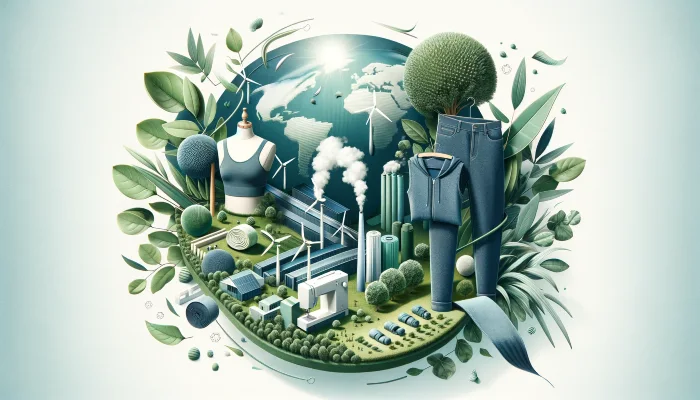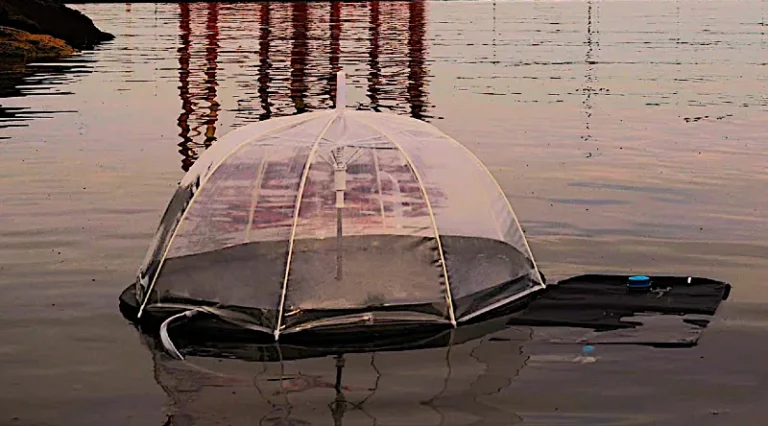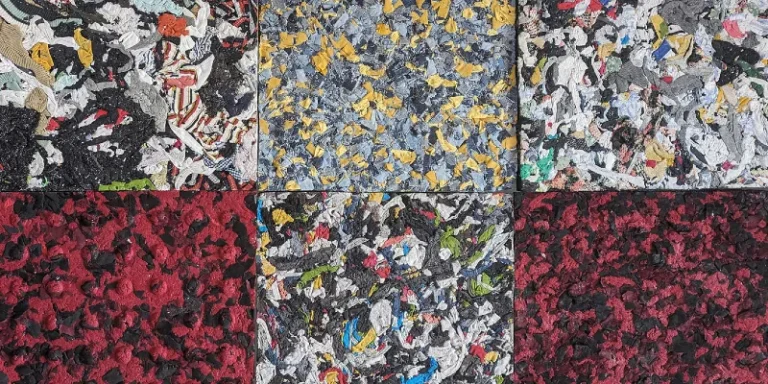Let’s dive right into the heart of what makes Tencel fabric a great fabric, not just for its stretch but for its broader appeal. Originating from the renewable resource of eucalyptus trees, Tencel has taken the fashion and textile world by storm. Renowned for its sustainability and versatility, it’s not just about creating cozy bedsheets ideal for warm nights or crafting activewear that complements your every move. The real magic of Tencel lies in its ability to remain resilient – retaining its softness and shape even after numerous washes.
The good news is that eco-consciousness is at the forefront of Tencel’s production. Through an advanced closed-loop system, the manufacturing process minimizes waste and energy use, making Tencel a prime example of how the industry is shifting towards more high quality sustainable wood sources. It’s a testament to Tencel’s commitment to the environment, making it an excellent choice for those with sensitive skin or anyone looking to add eco-friendly sustainable fibers to their wardrobe choices.
Key Insights:
- Sustainable Roots: Tencel, made from plant fibers of eucalyptus trees, is leading the charge in eco-friendly fashion.
- Adaptable Uses: From breathable bedsheets to flexible activewear, Tencel’s versatility is unmatched.
- Eco-Friendly Manufacturing: Its closed loop system production exemplifies innovation in sustainability, reinforcing Tencel’s role in promoting eco-conscious fashion.
Stretch and Flexibility: How A Eucalyptus-Based Fabric Is Stretchy
The secret behind the stretchiness of fabrics lies in their fiber composition. While natural fibers—like those from eucalyptus used in Tencel lyocell fabric—offer a degree of stretch, they’re inherently limited. Enter the realm of textile innovation, where the blending of Tencel with elastic fibers such as elastane transforms it.
This clever combination lends a gentle elastic stretch to Tencel garments, making them more accommodating to movement. It’s this fusion of comfort and flexibility that not only enhances fit but ensures your clothes bounce back to their original form, making Tencel an ideal choice for everything from your casual day-out outfits to your gym gear.
By focusing on both its environmental footprint and its performance as a fabric, Tencel sets a high bar for what textiles can achieve. Whether it’s the cool touch of bedsheets on a hot night or the support of activewear that moves with you, Tencel is proving to be a fabric that doesn’t just meet needs but anticipates them, all while championing sustainability.
Is Tencel Naturally Stretchy?
Curious about Tencel fabric? It’s made from eucalyptus tree pulp and is a champion of eco-friendliness. But does it stretch? At first glance, Tencel lyocell fabric, with its natural fiber roots, might not seem stretchy. This detail is crucial for those of us who value flexibility in our clothes.
Here’s the interesting part: while Tencel fibers on their own don’t stretch much, the manufacturing process cleverly introduces a bit of give. This isn’t due to Tencel’s own properties but comes from blending it with stretchy materials like elastane or spandex. The result? A fabric that not only keeps its shape but also offers the kind of stretch and comfort we love in everything from clothes to sheets—ideal for sensitive skin and warm climates.
The Power of Blends
When it comes to adding stretch, blending fibers is key. Pure Tencel lyocell fabric is wonderfully soft but doesn’t offer much give, which can be a limitation for certain designs. Enter the smart solution of mixing Tencel with synthetic fibers such as elastane. This little tweak adds the necessary stretch, enhancing Tencel’s natural perks with the flexibility and durability of synthetic fibers.
This blend not only boosts comfort but also widens Tencel’s appeal, making it versatile enough for everything from sleek activewear to snug, stylish dresses. It’s a perfect match of Tencel’s sustainability and the practical, stretchy benefits of man-made fibers.
By bridging the gap between natural and synthetic, this innovative approach allows Tencel to cater to a wider range of fashion needs. It’s a win-win: you get the breathable, eco-friendly qualities of Tencel along with the adaptable fit that modern lifestyles demand.
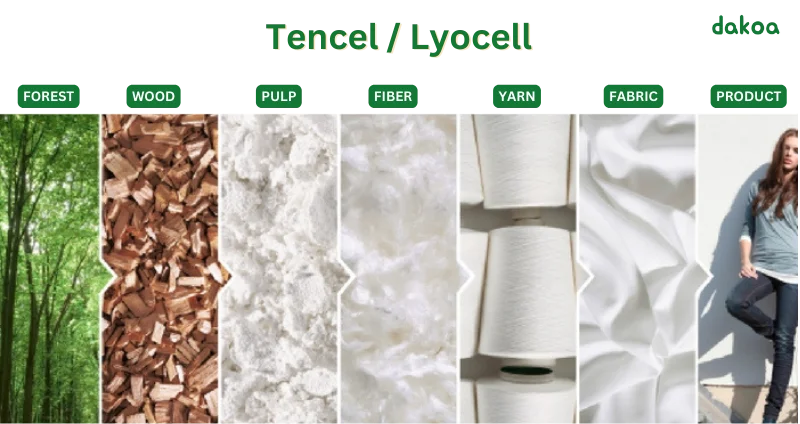
Knit vs. Woven Tencel Fabrics
When picking Tencel fabrics, the knit and woven types play by different rules. Knit Tencel, made from eucalyptus pulp, hugs your body with a gentle stretch, perfect for clothes that move with you. It keeps its shape well, making it a favorite for comfy, stretchy outfits.
Woven Tencel, on the other hand, is more rigid. Its closely interlocked threads offer less stretch but more structure, ideal for tailored pieces where flexibility isn’t the priority.
Choosing between knit and woven depends on what you’re making. For active wear that needs to stretch, go knit. For a sharp, structured look, woven is the way. This choice impacts how your Tencel piece feels and fits, ensuring you get the most out of this versatile fabric.
Advantages of Tencel for Activewear
Tencel stands out in activewear for its blend of comfort, performance, and eco-friendliness. Sourced from eucalyptus trees, a sustainable wood source, it brings unique benefits to the table. Its natural breathability and top-notch moisture-wicking keep you cool and dry, no matter how intense your workout.
Plus, Tencel’s softness is a boon for those with sensitive skin, offering a hypoallergenic, smooth touch that reduces irritation and allows for seamless movement.
Caring for Tencel is straightforward—its resilience means it holds its shape and size wash after wash, as long as you mind the heat. Choosing Tencel for activewear is more than a fabric choice; it’s a nod to a lifestyle valuing sustainability, comfort, and durability.
Tencel Fabric Care and Maintenance
Looking after Tencel garments means paying attention to the wash, Yes, the care instructions do require a little extra effort when using your washing machine. High heat is the enemy, leading to shrinkage. Instead, opt for a gentle cycle in cool water with a mild detergent to keep colors bright and the fabric lasting longer.
Keep rotary cutters away from your Tencel; they’re too harsh for its softness and can damage the fibers. When drying, lay Tencel items flat to avoid shrinkage from hot water or heat, keeping them looking as good as new.
Following these tips, your Tencel clothes will stay in great shape, making them a lasting addition to your wardrobe or sewing projects.
Tencel vs. Other Eco-Friendly Fibers
Let’s compare Tencel to other fibers, highlighting why it often takes the lead in sustainability and performance:
- Tencel vs. Organic Cotton: Both are eco-friendly, but Tencel’s moisture-wicking and breathability are unmatched, making it ideal for hot climates and sensitive skin. It has a luxurious feel, thanks to its soft hand and fluid drape, which organic cotton struggles to match. For stretch, Tencel blended with elastane offers flexibility without compromising its eco credentials, a feature organic cotton can only mimic by mixing with synthetic fibers.
- Tencel vs. Bamboo: Bamboo is touted for its eco-friendly profile, but its processing often involves harsh chemicals, detracting from its green image. Tencel’s closed-loop manufacturing is cleaner, maintaining its environmental integrity.
- Tencel vs. Synthetic Fibers: Synthetics like polyester offer stretch but lack Tencel’s breathability and eco-friendliness. Tencel blends provide a sustainable alternative with added stretch, marrying the best of both worlds.
- Tencel vs. Wool: Wool is a natural, renewable fiber but can be itchy and less sustainable due to its water and land requirements. Tencel offers a softer, more sustainable option for those looking for eco-friendly comfort.
In the sustainable fabric showdown, Tencel often comes out on top, balancing eco-friendliness with performance and comfort. Its ability to blend with other fibers like modal enhances its appeal, offering a versatile option for environmentally conscious fashion.
Choosing the Right Tencel Fabric for Your Sewing Project
Picking the right Tencel fabric means understanding what your project needs. Tencel comes from eucalyptus trees and doesn’t stretch much on its own. But, when mixed with stretchy materials like elastane or spandex, it gets the flexibility needed for clothes that fit well and move with you. This mix is perfect for Tencel jeans or active wear that requires a snug, comfortable fit.
Remember, caring for Tencel is easy. Wash it in cool water on a gentle cycle to keep it looking new. If you’re making active wear, the blend of Tencel and spandex is a winner for its comfort and ability to wick away moisture, keeping you cool and dry.
Getting advice from experts or experienced sewers can help you pick the best Tencel type for your project. They know all about the fabric’s qualities and can steer you in the right direction.

Environmental Benefits of Tencel
Tencel is a win for the planet. Its making process is super eco-friendly, thanks to a method that recycles almost all the solvents used. This approach cuts down waste big time.
Eucalyptus trees, where Tencel comes from, need much less water than cotton does, making Tencel a greener choice. Plus, when Tencel clothes are worn out, they can break down naturally without leaving a trace. This makes Tencel a smart pick for anyone looking to be kinder to the earth.
Busting Myths About Tencel
Some folks think Tencel fabric, made from eucalyptus trees, is naturally stretchy. Not quite true. Tencel itself isn’t stretchy like some synthetic materials. The stretch comes when it’s mixed with things like Spandex or made into a knit fabric.
Then there’s the durability debate. Some say Tencel can’t stand up to cotton denim or synthetics, especially after washing. That’s not right. With gentle care, Tencel items, from sheets to jeans, last a long time and keep their shape, all while being kinder to the planet.
And about handling the heat? Tencel’s awesome at it! Its breathability and moisture-wicking properties are perfect for staying cool and comfortable, making it a smart pick for everything from gym wear to summer outfits. So, no, going green with Tencel doesn’t mean you sacrifice performance.
Tencel in Action: Sustainable Success Stories From Brands You Know Using Lyocell
Tencel, the eco-friendly fiber renowned for its softness and sustainability, has become a darling of the fashion world. Brands and designers are falling for its mix of luxury, performance, and environmental responsibility. Here’s a deep dive into ways Tencel is revolutionizing the way we think about our clothes:
Performance Plus: Tencel Takes on Activewear
Athleta, the women’s activewear giant, understands the demand for high-performance clothing that cares for the planet. Their innovation team blended Tencel with elastane for a dynamic, moisture-wicking fabric ideal for workout gear. Think leggings that move with every stretch, yoga pants that feel like a second skin, and running tops that leave you feeling fresh. Plus, unlike many synthetic fibers, Tencel retains its strength when wet, meaning less sweat-induced stretching or loss of shape.
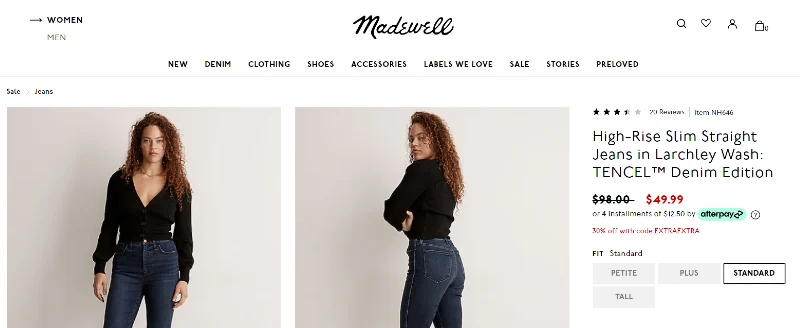
Denim Reimagined: Eco-Friendly Jeans
Jeans are usually synonymous with cotton, but brands like Madewell are pioneering Tencel in the world of denim. By masterfully blending Tencel lyocell and modal fibers, they’ve created jeans that are softer than traditional denim, more breathable, and offer a delightful hint of stretch. This innovation doesn’t sacrifice durability – think jeans that mold to your shape while resisting wear and tear. You get classic denim style with a reduced environmental footprint.
A Fashion Designer’s Favorite: Tencel on the Runway
Sustainable fashion icon Stella McCartney is a renowned champion of innovative materials, and Tencel is a staple in her collections. With its beautiful drape and ability to take vibrant dyes, Tencel lyocell makes an extraordinary impact in high-end garments. From flowing dresses to tailored suits, Stella McCartney consistently demonstrates that Tencel can create both everyday staples and red-carpet-ready designs with an ethical core.
Luxury in the Everyday: Tencel For Home and Sleep
Beyond the runways and fitness studios, Tencel is being welcomed into our homes. Bedsheet companies like Buffy and Ettitude weave Tencel into their bedding, resulting in luxuriously soft sheets that regulate temperature better than cotton and are ideal for sensitive skin. Eucalyptus-derived Tencel fibers ensure breathability and moisture control, allowing for comfortable sleep even in hot weather.
Outdoor Apparel’s Sustainable Upgrade
Patagonia, a pioneer in eco-friendly outdoor clothing, leverages the benefits of Tencel to create garments that not only perform but uphold their sustainability mission. Their lightweight hiking shirts blend Tencel with other natural fibers, delivering moisture-wicking capabilities and breathability ideal for hot weather adventures. The soft hand of Tencel minimizes chafing and discomfort, while its odor resistance adds a practical bonus for long days on the trail. Patagonia’s choice of Tencel underscores their commitment to responsible material sourcing, as the cellulose fibers are derived from sustainably managed eucalyptus trees.

Tencel Makes Loungewear Even Cozier
Eileen Fisher, renowned for elevated simplicity and dedication to natural fibers, finds a perfect match in Tencel. Luxuriously soft Tencel lyocell creates pants, tops, and jumpsuits that redefine loungewear style. These garments deliver unparalleled comfort without sacrificing an air of refinement. The fabric’s breathability, drape, and subtle luster are amplified by Eileen Fisher’s ethical commitment, emphasizing how good clothing can feel in all senses of the word. Consider these pieces if you’re seeking the ultimate at-home or effortless out-and-about wear.
TENCEL™ x Denim, For Everyday Wear
Founded by surfer Kelly Slater, Outerknown blends performance and sustainability into everyday clothing. Their S.E.A. Jeans prove that eco-conscious denim can be just as versatile and appealing as the classics. These jeans feature a thoughtful blend of TENCEL™ lyocell fibers and organic cotton, resulting in a softer, more breathable version of the iconic fabric. Their hint of stretch allows for freedom of movement and a fit that won’t sag throughout the day. Outerknown’s use of Tencel reinforces their commitment to reducing fashion’s environmental impact without compromising on quality or style.
Reformation: Understated Luxury With Tencel
Reformation, celebrated for its chic and sustainable collections, recognizes the power of Tencel to craft unforgettable dresses and separates. Tencel’s luminous drape and soft texture complement the brand’s effortless silhouettes. Reformation’s breezy summer dresses, blouses, and skirts woven with Tencel lyocell elevate everyday pieces. Whether you’re drawn to feminine detailing or classic lines, Tencel adds a touch of understated luxury and environmental consciousness, making them both wardrobe staples and feel-good investments.
Underwear: Tencel for Ultimate Comfort
Boody Eco Wear, an Australian brand dedicated to comfy, sustainable basics, is selling underwear for both men and women made from blends of Tencel lyocell and organic bamboo (yes, bamboo isn’t what we consider to be eco-friendly, but it’s a start), which they call Lyolyte. The resulting fabric is incredibly soft, temperature-regulating, and gentle on even the most sensitive skin. You’ll find briefs, boxers, and various undergarment styles to ensure maximum comfort and breathability in daily wear. Boody’s ethical sourcing and sustainable production process enhance the appeal of its Tencel underwear range.

The Fabric of the Future Is Helping Designers & Brands Be More Sustainable With Little Effort
These examples illustrate how Tencel is making a difference in the clothing industry. From athleisure to high fashion to comfy loungewear, its versatility, sustainability, and performance features make it a favorite for:
- Natural softness and breathability
- Moisture-wicking for workout gear
- Durable yet supple texture for denim
- Drape and vibrancy prized by designers
- Hypoallergenic properties for home textiles
Let Tencel Transform Your Wardrobe & The Planet)
So, the next time you’re rethinking your closet, consider seeking out Tencel fabrics. While we’re not saying that the brands currently working with Lyocell are sustainable, the material itself is a step in the right direction, so why not use your purchasing power to encourage these brands to keep up the green work! You’ll not only enjoy luxuriously comfortable clothing but also embrace sustainable innovation, proving that eco-consciousness and high style go hand in hand.
Tencel Fabric FAQ: Your Questions Answered
Q: What is Tencel, exactly?
A: Tencel is a brand name for a type of lyocell fabric, a fiber renowned for its softness, breathability, and ecological sustainability. It’s produced from wood pulp (typically from eucalyptus trees), processed in a closed-loop system that minimizes waste. Tencel offers luxurious drape and is often compared to silk or rayon, but with superior environmental credentials.
Q: How do I care for my Tencel garments?
A: Tencel is surprisingly easy to care for. Here’s what you need to know:
- Washing: Turn items inside out and use a gentle cycle in cold water with a mild detergent.
- Drying: Hang drying is ideal. If you tumble dry, use low heat and remove garments promptly.
- Ironing: Use a warm iron or steamer to address wrinkles. Avoid high temperatures.
Q: Can I use Tencel fabric for sewing projects?
A: Absolutely! Tencel is a fantastic choice for various sewing projects. Its beautiful drape makes it ideal for dresses, blouses, and skirts. If choosing Tencel for stretchy garments, check the “amount of stretch” as blends will adjust based on what other fibers are used. Select needles, cutting tools (rotary cutters can be great), and project-appropriate notions like any other fabric.
Q: Does Tencel shrink?
A: Like other natural fibers, Tencel lyocell fabrics may shrink slightly after the first wash. However, if cared for properly, subsequent shrinkage is minimal and the material comes close to holdings its original shape. Consider buying pre-washed Tencel or allow extra yardage if it’s crucial for sizing in your project.
Q: What are the environmental benefits of Tencel?
A: Tencel’s production stands out for several reasons:
- Sustainable Wood Sources: Tencel lyocell fibers are often derived from eucalyptus trees grown on sustainably managed farms.
- Closed-Loop System: Manufacturing uses a closed-loop system that recycles water and solvents, significantly reducing its environmental footprint.
- Biodegradable: Unlike many synthetic fibers, Tencel is biodegradable, a crucial benefit at the end of a garment’s life.
Q: Is Tencel a good choice for hot weather?
A: Yes! Tencel fabric is a great choice for hot and humid climates. It’s highly breathable, lightweight, and naturally moisture-wicking, helping you stay cool and comfortable. You’ll often see it in warmer-weather clothing and in bedsheets for that very reason.
Q: Are there any cons to Tencel lyocell fabric?
A: While Tencel has many great qualities, consider these points:
- Wrinkling: Tencel may wrinkle more readily than some synthetic fibers. Proper care techniques help minimize this.
- Pilling (Rare Instances): In areas of high friction, Tencel might pill over time. Choosing high-quality Tencel blends minimizes this.
- Cost: Depending on the source, Tencel can sometimes be more expensive than traditional cotton.
Lyocell vs. Tencel: Clearing Up the Confusion
Q: What’s the difference between lyocell and Tencel?
A: Tencel is a popular brand name for a specific type of lyocell. Lyocell is the generic name for this wood pulp-derived, eco-friendly fiber. All Tencel is lyocell, but not all lyocell is specifically Tencel.
Q: Does Tencel hold its shape better than generic lyocell?
A: Both Tencel and high-quality lyocell are known for retaining their original shape well when cared for properly. Lenzing, the British company behind Tencel, has exceptionally rigorous quality control standards, ensuring fabric consistency.
Q: When you talk about Tencel, is it a natural or man-made fabric?
A: Tencel/lyocell falls into an interesting category! It’s considered a man-made fabric because it undergoes a chemical process to transform wood pulp into fibers. However, the base material (often eucalyptus wood) is entirely natural, giving it a plant-based origin unique among many synthetic fibers.
Q: Can lyocell fabrics shrink and is machine washing okay?
A: Like other natural materials, lyocell may experience some minimal shrinkage during the first wash. For best results, stick with a cold, gentle machine wash cycle followed by hang drying. This helps maintain the original size and shape of your garment.
Q: I’m curious about trying Tencel. Can I get a sample of this fabric before committing to a larger purchase?
A: Yes! Many fabric retailers offer samples or swatches of Tencel/lyocell fabrics. This gives you a chance to experience the unique physical properties of the fabric and experiment with the drape and weight before making a final decision.
Tips for Shopping & Caring for Lyocell/Tencel
Q: Where can I find the best lyocell clothing and fabrics?
A: Eco-focused brands, outdoor apparel companies, and online fabric retailers carry a wide selection of Tencel/lyocell clothing and fabrics. Look for companies transparent about their production methods and sustainability practices. Don’t forget to refer to the section above that mentions several brands that are currently working with Tencel.
Q: Are free domestic shipping orders common for Tencel fabrics?
A: Many online retailers offer free domestic shipping on fabric orders over a certain purchase amount. Some specifically advertise this in their listings, so look out for offers that benefit your project!
Wrapping Up: The Flexible Future of Tencel
As we’ve seen, Tencel is more than just a fabric; it’s a testament to what sustainable fashion can achieve. Sourced from eucalyptus trees and produced through an eco-friendly closed-loop system, Tencel sets the bar high for environmental responsibility. While it’s not stretchy by nature, the magic happens when Tencel is blended with elastane or spandex, or when it’s knit instead of woven, giving it the flexibility many of us look for in our clothes.
The care Tencel needs is simple but crucial—avoid high heat to keep its quality and shape intact. This attention to care helps Tencel items last longer, proving that eco-friendly choices can also be durable and practical for everything from soft bedsheets to sweat-wicking activewear.
More To Discover
Comparing Tencel to other materials like organic cotton highlighted its unique advantages, from its luxurious drape to its ability to innovate in stretchy fabrics. We’ve debunked myths and celebrated real-world successes, showing that Tencel isn’t just keeping pace but setting trends in sustainable fashion.
Looking ahead, Tencel’s journey is far from over. Its role in the textile industry continues to evolve, promising a future where fashion not only looks good and feels great, but also honors our planet. Tencel is leading the way, proving that sustainability and style can go hand in hand, making it a beacon of hope for a more eco-conscious world.








